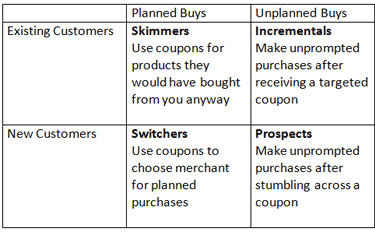If I could click my heels together and give every merchant in the world one capability, it would be unique codes, used today primarily for coupons. So much of modern marketing depends on the ability to differentiate the customer experience, and unique codes are the glue that makes it possible.
Traditional coupons do not differentiate. People who would have bought anyway search them out and use them extensively—especially online. As an acquisition vehicle, they can be effective, but paying to reacquire customers is bad for margins.
Unique codes can be adapted to a wide range of uses, from coupons to event invitations to exclusive content or products. In every case, they remove the downside financial risk and let marketers focus entirely on using their creativity to come up with great ideas to recognize, reward and incentivize customers.
Technologically, unique codes are pretty simple. A code is generated and associated with a particular value or set of rules. Campaigns assign a code to each recipient. A table somewhere is accessed to validate and consume the code.
What’s needed is access to a master code repository. The right approach will depend on your current technology vendors and your internal abilities—and budget! Most modern Web stores can handle this and act as your repository; if yours can’t, an upgrade may be in order.
How to use unique codes
Unique codes unlock the pantheon of retention marketing tools. Let’s start by understanding a simple model of coupon usage:

When you throw coupons into the wild, you are praying for Switchers, Incrementals and Prospects, but getting lots of Skimmers.
By shifting to unique codes, you can accomplish the following:
- Ensure your best customers get your best offers: That doesn’t mean you always discount for them. It may mean identifying those at risk and reactivating with your very best offers, which would be disastrous if in the hands of the general public.
- Avoid collision across channels: Different offers in print and online can cause havoc for call centers or store personnel. A single repository removes any chance of irritated customers or overlap.
- Enable rebates and loyalty program rewards: Codes make reward fulfillment a snap, whether as discounts, service benefits, or product credit.
- Greatly increase reporting accuracy and insights: Suddenly your ability to understand response rates and allocate expense by marketing vehicle are greatly expanded, allowing far better resource allocation and future marketing planning.
- Incorporate meaningful offline lead generation: Codes can be built into the event management process, where customers redeem codes for benefits, offers, or rewards.
- Control offers through partners: When acquiring customers through partners, unique codes can ensure control of the campaign’s cost.
These are just basic ideas. You can create complex and nuanced layers of offers and benefits based on customer segmentation, designed to increase frequency, migrate good customers upwards, and keep marketing expense under control.
Michael Greenberg is chief operating officer of Loyalty Lab, a provider of SaaS loyalty marketing systems for consumer brands.